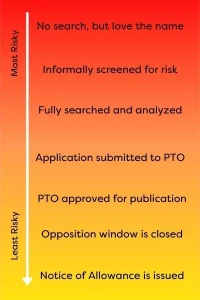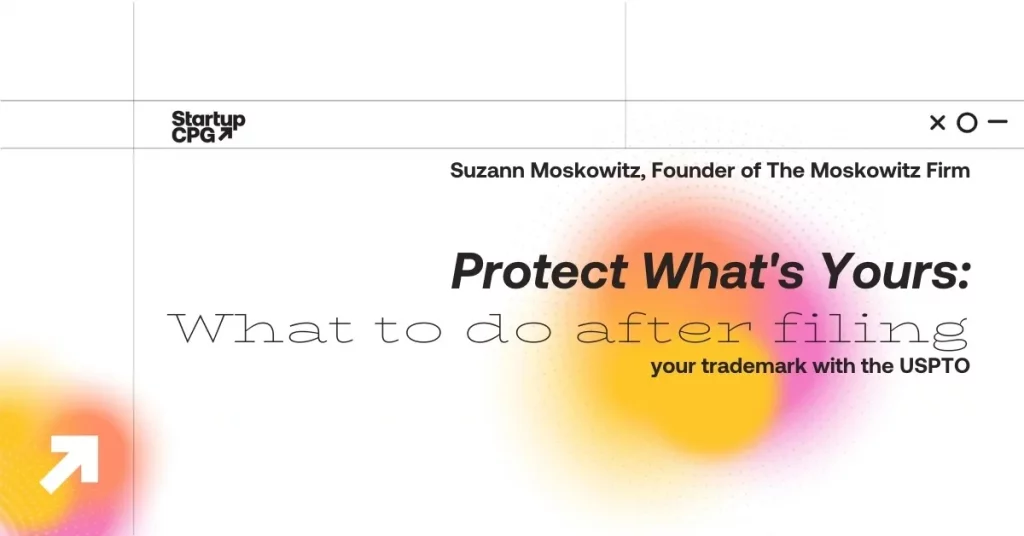Keep What’s Yours:
What to Do After Filing
Suzann Moskowitz is the owner of a boutique law practice, The Moskowitz Firm, focused on brand protection, copyright, and related technology and licensing issues. For nearly two decades, Suzann has worked closely with creative entrepreneurs, technology start-ups, foodie founders, and companies large and small to protect their valuable intellectual property and to navigate evolving legal landscapes.
This series introduced the fictitious plant-based brand, ChickTwin; its quest to understand the basics of trademark protection, (available here); and provided an in-depth view of how to choose a strong, protectable brand (here). In this edition, we address the common question of “what now?” from the trademark-pending period, through enforcement and renewals.
1. I got my USPTO receipt and a serial number. What happens now?
Despite the government’s claim that applications are reviewed in 4-5 months, due to a huge influx of applications before a 2021 fee increase, typical applicants now wait at least 6 months to hear anything. While that wait can be excruciating for a company eager to launch, it is important to remember that filing holds your place in line, opens doors to Amazon Brand Registry, and puts others on notice of your rights- even if your product is still in beta.
If your application was based on actual use in commerce (i.e., you were actually selling the real thing under the brand), there’s no need to reach out to the USPTO while you wait.
Timing of Launch: a Risk Continuum
 However, if like ChickTwin, you wisely filed BEFORE launch using the Intent to Use (“ITU”) procedure, you have some choice when it comes to launch timing:
However, if like ChickTwin, you wisely filed BEFORE launch using the Intent to Use (“ITU”) procedure, you have some choice when it comes to launch timing:
- Risk Tolerant: move forward with full brand reveal and product launch once the USPTO application has been submitted (which, as shown in the graphic, is certainly safer than announcing before searching and filing.)
- Careful: wait until you get the initial nod from the USPTO, either an Office Action indicating that there are no third parties blocking you, or notification that you are “Approved for Publication.” In either case, the path to a full registration (and the right to use the esteemed ® symbol) is *mostly* clear and it might be a good time to plug the trigger on a splashy public launch.
- Risk Averse: clear up all administrative hurdles (like wording issues), endure the 30-Day Public Opposition Window (an opportunity for your competitors to say “I know the USPTO didn’t see a conflict here, but we do!”), and wait for the “Notice of Allowance” before investing in things like final packaging and promotion.
ITU applicants must submit evidence that the product is real and being sold (or at least taken over state lines for sale) before finalizing a registration. Because this proof-of-use requires additional investment ($100 USPTO fee per class plus attorney time to assemble specimens and submit the necessary paperwork), some owners prefer to wait for the Notice of Allowance – making sure there are no obstacles to registration before spending another penny.
While you don’t lose your place in line by waiting, submitting specimens of use earlier in the process can speed up examination a bit. And if launch is delayed, companies can file six-month extension requests with a nominal fee. The USPTO’s official timing flowcharts can be accessed here.
2. What else should I be doing while I wait?
MONITOR
Google® Alerts are a free and easy way to keep an eye on how your brand may be popping up on third party sites. But a serious brand investment justifies formal monitoring of new applications, particularly at the USPTO. (Click here for more background on monitoring.)
IDENTIFY NEW IP
For many companies, the final logo is developed after the original word mark is filed. This interim period is a good time to identify new pieces of IP worth protecting including such designs as well as taglines.
FILE INTERNATIONALLY
Likewise, it’s also an excellent time to consider international brand protection strategy. If filed within six months of the initial USPTO filing, most major jurisdictions avail applicants of the benefit of using that original filing date as the effective date of filing in those selected countries (Incidentally, this is the same method major league teams and tech companies use to keep names secret, by filing overseas first and then claiming an earlier date in the US after the big reveal.)
You may wish to consult with counsel regarding the best strategy for overseas filing which can be done directly in each country or through a generally more cost-effective process coordinated between the USPTO and WIPO.
3. My Certificate has arrived! What should I do after framing it?
BRAND STANDARDS
While a formal brand standards manual is ideal, even a short set of trademark use guidelines will help your team with:
Knowing whether and where to use TM (for pending marks) or ® symbol (for registered marks)
Being consistent about wording and design elements, so as not to lose rights based on nonuse or material alteration
A process for vetting and protecting new marks before they are made public
ENFORCEMENT
Continue to monitor third-party uses, enforce against problematic new filings though various objection processes at the USTPO, and, where appropriate, send cease and desist letters. Think carefully about reaching out hastily and assume that any letter sent on behalf of your company will be published. But it is sometimes best to take some action early to avoid being accused of waiving the right to enforce in the future when a larger problem brews.
4. What’s all this spam? Did I miss a renewal deadline?
Applicants are bombarded with fraudulent notifications with deceptive information about deadlines, the need to submit information to various registries, and other sketchy “opportunities” regarding brands and domain names. Genuine notifications come from the USPTO and may be shared by trademark counsel, but technically speaking, the obligation is on the brand owner to properly record and manage deadlines.
Post-filing deadlines to note:
- Continued Use Declaration – required between 5th-6th year after registration
- Incontestability Declaration – optional but recommended to increase strength of registration. Can be filed any time after 5 years of consistent use
- Renewal – required between 9th-10th year after registration and then every ten years
Looking to the future, ChickTwin’s strong trademark portfolio including logos, taglines, and rights in many major jurisdictions makes it an appealing candidate for licensing, investment, and acquisition.
Stay tuned for more lessons from the ChickTwin Duo including packaging and copyright matters.
This article is provided for informational purposes only, and should not be construed as legal advice.






All Comments